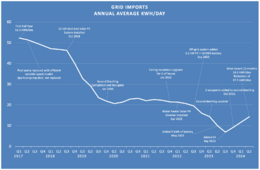nd used 6900 kWh last month. Part of my problem is a pool pump that isn't efficient and I'm sure the house could be insulated a lot better. Three 4 ton heat pumps and an electric water heater to boot.
OK so before focussing on the supply side, some work done on the demand side will help.
Proper insulation, draft proofing and window treatment (e.g. external shading, double glaze, blind/curtains) will make a big difference to the thermal performance of the home and can cut cooling energy demand significantly. This will likely be your biggest energy demand item and so should be a priority.
The pool pump can be replaced with a variable speed model - they are way more efficient. And pool pumps can be programmed to run when power is cheapest. My VS pool pump uses about 25-30% of the energy my old single speed pump did. And running it at the time of cheapest energy (which nowadays is when solar PV is generating) resulted in pool pump energy costs falling to 15% of what it was when we moved here.
Electric water heating also has options.
If the water heater is old / nearing end of life then consider swapping it out for a heat pump water heater. they will use ~ 1/4 of the electrical energy of a regular electric water heater. There may even be incentives where you for doing so.
Much like the pool pump water heater operation can be timed to run when power supply is cheapest (be it from your own solar PV or from off-peak energy). The basic principle is to have a tank large enough to be heated once a day when energy is cheap so that it can supply hot water for the rest of the day. Hot water tanks are cleverly simple - the water naturally stratifies into hot on top, cold down low with very little mixing in between, which is why you can heat it over a matter of hours once a day while still have hot water supply 24 hours a day.
My own tank (315 litre resistive element) uses a PV diverter which cleverly diverts whatever excess PV generation there is to the water heater's resistive element. We also heat it at super off-peak times if the solar PV is insufficient. Our water heater operational cost is now about A$30/year (about US$20/year).
Pool pumps and water heaters do also have the option of having dedicated off-grid PV but to me it's better to have PV capacity available for any demand rather than be confined to one job.
But on the supply side:
Keep in mind that getting to zero grid draw is not necessary with your own system. The idea is to use it to reduce your energy supply costs but in a cost effective manner. Often the first half of the reduction in grid energy draw can be done fairly easily and relatively cost effectively but it gets harder and less cost effective to close the gap to 100% self sufficient. This is why reducing demand to begin with is so helpful. But for sure consider options that make sense in you area - that will vary by location. Here grid-tied PV is cheap, easy and encouraged but that's not the case everywhere.
Of course if you have the option do some energy supply shopping. It's different everywhere - we have several dozens retailers and hundreds of plans options (it's actually quite complicated!). You mentioned possibility of having access to cheap energy periods because you have an EV. We have that too, we get free energy 2 hours a day 12-2PM, so I load up the EV, off-grid home battery and if needed the water heater plus that's when the dishwasher and clothes washing get done.
Good luck with it. While our consumption is not at your levels, this is how our grid imports have tracked over the years:

 I am trying to find a way to tame my power bill before I retire in a few years.
I am trying to find a way to tame my power bill before I retire in a few years.


